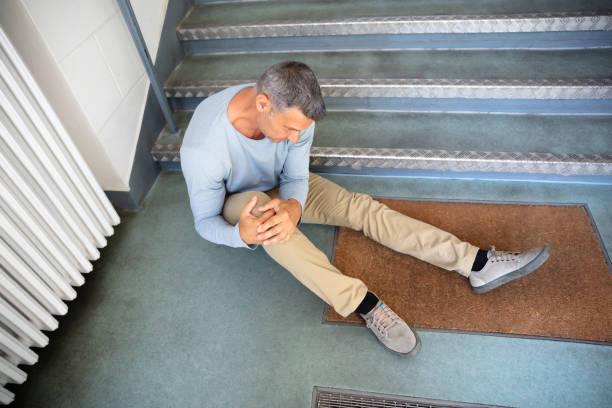Medical Treatment Options for Common Slip and Fall Injuries

Slip and fall accidents usually occur suddenly and unexpectedly, leaving individuals with various injuries. Whether it’s a fractured bone, a sprained joint, or soft tissue damage, seeking prompt and effective medical treatment is essential for a full recovery. This thorough guide will offer more information about the various medical treatment options for the most common slip and fall injuries so you can make the best decisions for your health.
Soft Tissue Injuries
Soft tissue injuries encompassing strains and sprains are common consequences of slip and fall accidents. These injuries are most of the time painful and limit mobility. Effective treatment options for soft tissue injuries include:
- Initial management with RICE: The immediate response to a soft tissue injury often involves the RICE method: Rest, Ice, Compression, and Elevation. Resting the injured area helps prevent further damage, while applying ice reduces swelling and discomfort. Compression with a bandage further aids in controlling swelling, and elevation helps reduce fluid buildup.
- Physical rehabilitation therapy: Once the initial inflammation subsides, physical therapy plays a significant role in recovery. Physical therapists design individualized exercise programs to strengthen and rehabilitate the injured muscles, tendons, and ligaments. These exercises promote healing, restore range of motion, and prevent long-term complications.
- Pain management: Managing pain is important in soft tissue injury treatment. Generally, over-the-counter or prescription medications may be recommended depending on the severity of the pain. These medications help reduce pain and inflammation, making recovery more manageable.
Head Injuries
Head injuries, particularly concussions and traumatic brain injuries (TBIs), demand immediate medical attention and specialized care. Treatment options for head injuries include:
- Immediate medical evaluation: When head injuries are involved, your slip and fall lawyer in Indianapolis will urge you to seek prompt medical attention is paramount. Healthcare providers assess the injury’s severity, guiding the treatment plan. Some head injuries may require close monitoring and rest, allowing the brain to heal naturally.
- Rehabilitation therapies: Rehabilitation therapies come into play for more severe head injuries. Physical, occupational, and speech therapists may be involved in rehabilitation. These professionals help patients regain lost skills, improve cognitive function, and improve quality of life.
- Long-term care and monitoring: In cases of TBIs, ongoing care and monitoring are essential. Patients may require extended rehabilitation, counseling, and support services to manage the long-term effects of the injury. Regular check-ups and evaluations help ensure that any emerging issues are addressed promptly.
Back and Spinal Cord Injuries
Back and spinal cord injuries are often complicated and require specialized treatment approaches. Here, we explore the various aspects of managing these injuries:
- Bracing for stabilization: Bracing may sometimes be necessary to stabilize the spine and support the healing process. Braces help maintain proper alignment and reduce the risk of further injury.
- Physical therapy for mobility: Physical therapy plays a vital role in recovering from back and spinal cord injuries. These programs focus on improving mobility, strengthening muscles that support the spine, and enhancing overall function. Physical therapists design tailored exercise regimens.
- Surgical intervention for severe cases: Surgical intervention may be necessary in cases of severe spinal cord injuries or fractures. Surgeons may perform procedures to stabilize the spine, remove damaged tissue, or address other specific issues. Surgical approaches can vary depending on the level and location of the injury.
Cuts and Lacerations
Cuts and lacerations, while not always severe, require proper wound care to prevent infections and promote healing. Treatment options include:
- Thorough cleaning and dressing: Properly cleaning the wound and applying sterile dressings are critical steps in wound care. Thorough cleaning removes debris and potential contaminants, reducing the risk of infection. Sterile dressings protect the wound and promote a suitable environment for healing.
- Sutures or staples for closure: Healthcare providers may use sutures or staples to close the wound in deep or gaping wounds. This helps facilitate the healing process and minimizes scarring. Suture removal typically occurs once the wound has sufficiently healed.
- Antibiotics when infection is a concern: Antibiotics may be prescribed if there is a risk of infection. These medications prevent or treat infections, ensuring the wound heals without complications.
Hip Injuries
Hip fractures are a significant concern, particularly among older adults who are more vulnerable to these injuries. Treating hip injuries involves several aspects:
- Surgical intervention for stability: In most cases of hip fractures, surgical intervention is necessary to repair or replace the fractured hip bone. Surgery aims to restore stability and function to the hip joint.
- Physical rehabilitation therapy: Physical therapy becomes crucial to the recovery process following hip surgery. Physical therapists help patients them regain strength, mobility, and balance. These exercises are personalized to the patient’s specific needs and abilities.
- Assistive mobility devices: Depending on the patient’s condition and mobility, assistive devices such as canes, walkers, or crutches may be recommended. These devices provide support and help individuals move safely during their recovery.
Contusions and Bruises
Contusions and bruises, while typically less severe, can still be painful and inconvenient. Proper care for these superficial injuries includes:
- Rest and ice for relief: Resting the injured area and applying ice can help take down the swelling and alleviate discomfort. These simple measures are effective in managing contusions and bruises.
- Over-the-counter pain relief: Common over-the-counter painkillers can alleviate pain and inflammation associated with contusions and bruises. These medications are accessible and easy to use for self-management.
Don’t Let Your Injuries Bring You Down
Slip and fall injuries vary widely in their nature and severity, but effective medical treatment is vital for achieving a full recovery. The bottom line is that seeking prompt medical attention and adhering to recommended treatments are essential to recovery.

